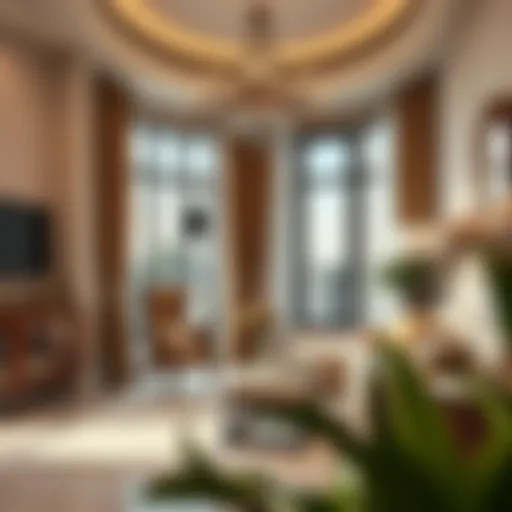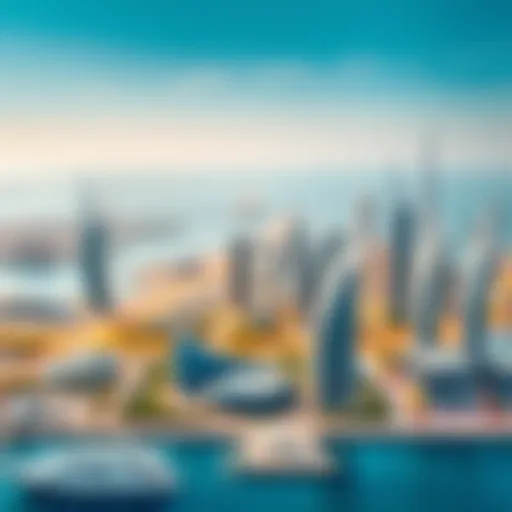Interior Design Trends and Insights in Dubai
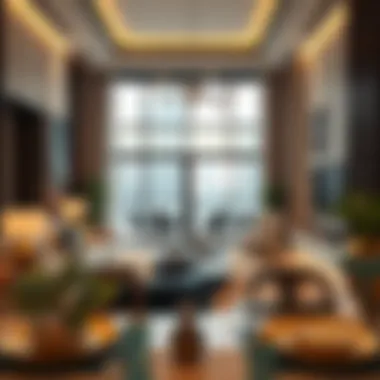
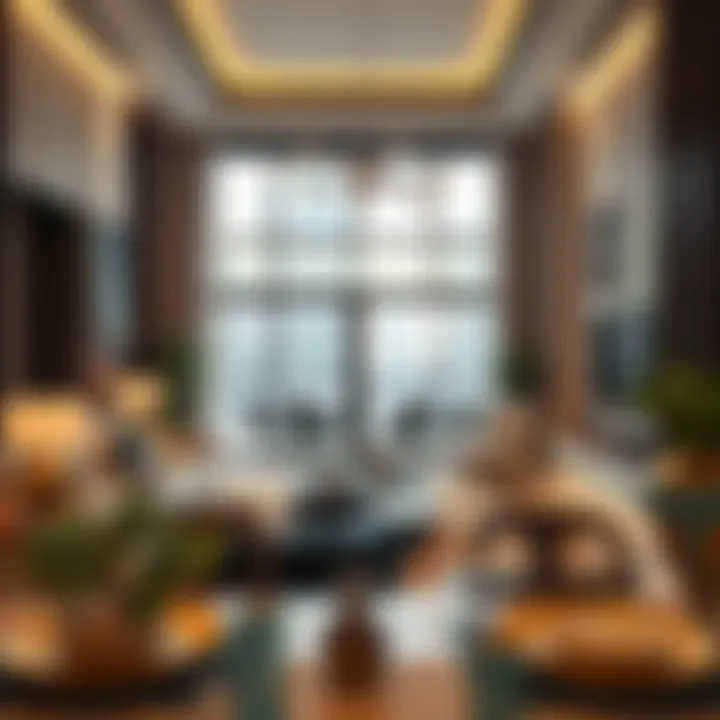
Intro
In the heart of the Middle East, Dubai stands as a beacon of architectural innovation and style. The interior design landscape here reflects not just personal tastes but also cultural richness and economic dynamism. Homeowners, investors, and industry professionals alike are keen to grasp the myriad of influences shaping this vibrant scene.
With an ever-evolving skyline and luxurious lifestyle, Dubai's interior designers have the responsibility of weaving together aesthetic vision with function. This article goes beyond the glitzy surface, diving into the nuances that characterize Dubai's interior design market. An understanding of these components is vital for anyone looking to invest, develop, or simply appreciate the sophisticated layers of interior design in this city.
Market Insights
Understanding the inner workings of the interior design market in Dubai is crucial for stakeholders. The intersection of cultural influences, economic factors, and consumer behavior creates a unique environment that demands attention.
Current Trends in Dubai Real Estate
Dubai’s real estate market exhibits patterns that draw both local and international buyers. Recent trends show an increased appetite for sustainability; many designers are focusing on eco-friendly materials and designs that are not just visually appealing but also responsible. Vertical gardens, energy-efficient fixtures, and locally sourced décor are becoming commonplace in new residential developments.
Another noticeable trend is the rise of multifunctional spaces. The modern homeowner often seeks designs that are versatile. This is particularly important as many families in Dubai opt for open-plan living arrangements, which encourage social interaction while allowing for practical use of space.
Economic Factors Impacting Property Values
The economic landscape of Dubai has a direct influence on property values and, by extension, interior design merely. Factors such as the prevailing tax regulations, foreign investment laws, and fluctuations in oil prices all contribute to the demand within the real estate market. There has been a steady growth in expatriate communities, with a significant number of individuals looking to invest in luxurious interiors that reflect their heritage and lifestyle.
"The evolution of interior design in Dubai is not merely about aesthetics, but also about creating environments that fulfill diverse needs in a fast-paced urban setting."
This growing demand inevitably raises property values, prompting homeowners and developers to seek out top-tier interior designers who can meet these needs. It’s a delicate balance between luxury and practicality that shapes the creative direction of many designers today.
Investment Guides
For those considering entering the Dubai real estate market—be it as a homeowner or an investor—gathering knowledge on the interior design aspect can provide a competitive edge. Knowing what to look for in design can make all the difference in maximizing property value.
Tips for First-Time Buyers
- Research Neighborhoods: Each district in Dubai has its own aesthetic and demographic. Understanding these can aid in making better choices.
- Engage with Designers: Don’t just settle for what you see. Speak to interior designers who specialize in the styles that resonate with your personal taste.
- Consider Future Trends: Look for properties that allow customization, as design preferences can change over time.
Portfolio Diversification Strategies
Investors should think about how interior design can enhance property appeal. Consider the following:
- Invest in Emerging Areas: New developments may give a great return on investment if the right design elements are in place.
- Focus on Technology Integration: Smart homes are becoming a crucial selling point. Look for designs that seamlessly incorporate technology to attract tech-savvy buyers.
- Sustainability Factor: Properties that feature sustainable designs often see appreciation in value as eco-awareness grows.
For more detailed insights on the Dubai interior design market, you might check sources like Wikipedia or industry-specific forums such as Reddit.
With a comprehensive understanding of these dynamics, stakeholders can navigate the intricate web of Dubai’s real estate and interior design market more effectively.
The Evolution of Interior Design in Dubai
Dubai’s landscape of interior design has transformed dramatically over the years, mirroring the rapid development of the city itself. Once a modest enclave, the city has burgeoned into an international hub, and its interior design scene is no exception. The evolution of interior design in Dubai encapsulates a blend of historical context, modern flair, and global trends that come together to shape its unique architecture and interiors.
Understanding this evolution offers multiple benefits. For investors and developers, it highlights the potential opportunities in the market driven by cultural richness and innovation. Homeowners and designers alike can gain insights into the intricacies that contribute to a space’s identity and value, equipping them to make informed decisions when creating or renovating spaces. This evolution isn't merely a timeline of design styles but a reflection of the social, economic, and cultural tapestry that is Dubai.
Historic Influences
The historical influences on Dubai's interior design are deeply rooted in its past as a small trading port. As Bedouin traditions intermingled with international trade, the early designs were characterized by simple materials and functional spaces. Early interiors often featured
- Textile collections: derived from neighboring countries,
- Ornate metalwork: inspired by Islamic architecture,
- Traditional motifs: symbolizing local heritage.
Over the decades, as oil wealth transformed the economy, the design aesthetic transitioned significantly. The influx of wealth attracted global influences, allowing local designers to experiment and innovate. Iconic sites like the Burj Khalifa and the Dubai Mall showcase this blend, where historic styles juxtapose modern luxuries. This duality is a signature of Dubai's identity, making it imperative for modern designers to respect these roots while embracing contemporary styles.
Modern Trends Shaping Design
In recent years, new trends have emerged that cater to an evolving clientele. Today's interior designers in Dubai often emphasize the following:
- Minimalism: An appreciation for sleek lines and uncluttered spaces reflecting sophistication and tranquility.
- Biophilic Design: Integration of natural elements to foster a connection with the outdoors, promoting well-being.
- Smart Solutions: The infusion of technology into homes which shape user experience across design aesthetics.
- Color Psychology: Attention to how hues impact mood and atmosphere, tailoring designs to foster specific feelings.
These trends demonstrate a shift from ornate embellishments toward a focus on experience and emotional connection with the space. For example, the use of plants in interior spaces has become prevalent, enhancing air quality and adding vibrancy to otherwise stark settings.
Global Influences in Local Design
It's no secret that globalization has had its fair share of impact, and Dubai, as a melting pot of cultures, reflects this well. Designers are now drawing inspiration from diverse styles—from Scandinavian minimalism to Japanese wabi-sabi principles. This intercultural exchange not only elevates designs but also caters to an international clientele that seeks bespoke solutions.
Additionally, events such as the Dubai Design Week have catalyzed this global influence, serving as a platform for local and international designers to showcase innovative projects. Collaborations with renowned names from abroad often push the envelope further, resulting in extraordinary structures that stand as a testament to Dubai's commitment to fostering creativity.
"Dubai’s design scene acts as a canvas where local cultures intermingle with global influences, resulting in spaces that are as dynamic as the city itself."
The evolution of interior design in Dubai is thus a tapestry woven from its history, modern trends, and global interactions, generating a vibrant and continuously changing field. Understanding these elements equips professionals and enthusiasts alike with the knowledge to navigate the complexities of this dynamic industry.
Defining Characteristics of Dubai's Interior Designers
Understanding the defining characteristics of Dubai's interior designers can unveil the layers of creativity and cultural expressions that shape a space. This section examines several vital elements that set these professionals apart in a competitive market. Cultural sensitivity, a fusion of luxury and functionality, and sustainability initiatives are not just trends; they embody the principles that enhance the overall quality and appeal of designs in this vibrant city. As investors, agents, developers, and buyers navigate the landscape of interior design, grasping these characteristics can significantly impact decision-making and strategic planning.


Cultural Sensitivity in Design
Cultural sensitivity is paramount in Dubai’s interior design sector due to the emirate's diverse population. Designers must navigate a delicate balance between maintaining cultural integrity and meeting modern aesthetic standards. This sensitivity manifests in various ways:
- Use of Local Aesthetics: Designers often integrate traditional Emirati elements, such as intricate geometric patterns, motifs inspired by nature, and local art, into contemporary design. This blending creates spaces that resonate with both expatriates and locals, establishing a sense of belonging.
- Respect for Customs: The recognition of cultural practices is vital. This includes creating spaces that respect privacy, particularly in residential designs. For instance, housing complexes often feature separate entrances for male and female visitors, reflecting cultural norms.
- Diverse Clientele Considerations: With clients hailing from various regions, from Europe to Asia, understanding and respecting different cultural backgrounds play a critical role in establishing rapport and delivering a satisfactory design solution.
"Cultural sensitivity is not merely a checkbox; it's about creating spaces that people can truly call home."
Fusion of Luxury and Functionality
In Dubai, luxury isn’t just a characteristic; it’s the gold standard. However, luxury doesn’t always mean extravagance. Interior designers skilfully merge opulence with everyday functionality, resulting in designs that are both beautiful and practical. Consider these aspects:
- High-End Materials: Designers often select premium materials, such as marble, exotic woods, and high-quality textiles, which symbolize luxury while ensuring durability and ease of maintenance.
- Innovative Design Solutions: Space optimization is key, especially in high-density urban areas. Designers implement multi-functional furniture, such as convertible sofas or extensible dining tables, that add versatility without compromising elegance.
- Technological Integration: The latest smart home technology and automation systems are seamlessly incorporated, enhancing the user experience without overwhelming the aesthetic appeal of the space. From controlling lighting to temperature from afar, functionality intertwines with luxury effortlessly.
Sustainability Initiatives
Sustainability is gaining momentum in Dubai’s interior design scene as environmental consciousness becomes increasingly significant. Designers are adopting sustainable practices to create eco-friendly spaces that appeal to the modern, socially aware client. Examples include:
- Eco-Conscious Materials: The use of materials that are sustainably sourced or recycled not only minimizes environmental impact but also tells a story. This could be reclaimed wood or sustainably produced textiles, contributing to a greener ecosystem.
- Energy Efficiency: Innovative designs that prioritize energy efficiency are essential. Strategically placed windows for natural light or energy-saving appliances can drastically reduce a space's carbon footprint, aligning with Dubai's broader sustainability goals.
- Biophilic Design: There is a growing trend towards incorporating nature into interior spaces, utilizing plants and natural elements to enhance well-being while simultaneously improving air quality. This approach taps into a desire among clients for both aesthetics and healthier living environments.
As the interior design landscape in Dubai continues to evolve, these defining characteristics not only help shape the identities of individual designers but also contribute to the city's broader cultural narrative. In a city known for its rapid growth and diversity, these unique elements help clients connect with their spaces on a deeper level, making each design project a true reflection of Dubai's dynamic identity.
Notable Interior Design Firms
In Dubai, the interior design landscape is vibrant and diverse, characterized by a blend of local innovation and global trends. The importance of highlighting notable interior design firms cannot be overstated; these firms not only shape the aesthetic and functional aspects of residential and commercial spaces but also reflect the wider cultural and economic currents in one of the world's most dynamic cities. Understanding which firms are leading the charge offers valuable insights for investors, developers, and homebuyers alike.
Emerging Names in the Industry
Among the notable firms making waves are those that have carved a niche in providing fresh perspectives and innovative solutions. For instance, XBD Collective stands out with their mix of artistry and practicality, embracing a style that emphasizes clean lines paired with warm palettes. Their portfolio, which includes modern apartments and boutique hotels, showcases a commitment to blending functionality with elegance.
Another name to look out for is Nabil Gholam Architects, who have taken a distinctive approach in fusing traditional design elements with contemporary aesthetics. This integration not only caters to a diverse clientele but also embodies the cultural tapestry of Dubai.
These emerging firms bring along a spirit of experimentation—be it through sustainable materials or technology-driven designs, they often challenge the status quo.
Established Pioneers
While emerging firms generate excitement, the established pioneers in Dubai's interior design realm lay the foundation upon which newer companies build. Firms like Killa Design have earned their reputation through iconic projects such as the Dubai Frame. These veterans command respect, not just for their portfolio but also for their ability to influence the market and mentor the next generation of designers.
Another stalwart in the industry, Designs by Tia, has become synonymous with luxury living. Their mastery over blending the opulent with the livable encapsulates the essence of high-end Dubai interiors, making them a go-to for discerning clients.
Established firms often provide stability in an otherwise volatile market; their extensive networks and deep understanding of regulatory frameworks enable them to navigate challenges effectively.
International Firms with Local Presence
Dubai's allure also attracts international firms with local presence that bring a global perspective to the market. Companies like Gensler create designs that resonate with the local context yet maintain an international flair, which appeals to a broad demographic.
Another relevant player is HOK, recognized for their innovative approach to space planning and design. Their projects, ranging from corporate offices to high-end residential spaces, emphasize efficiency and aesthetics, effectively harmonizing global standards with local preferences.
These firms, through joint ventures or partnerships with local designers, manage to provide clients a unique blend of international expertise and local insights, which is essential for successfully navigating the local design landscape.
"Design is not just what it looks like and feels like. Design is how it works." - Steve Jobs
For further reading, consider visiting resources like Wikipedia and British Council for insights into design principles or exploring discussions on platforms such as Reddit focusing on contemporary design trends.
Client Expectations and Design Briefs
The relationship between a client and an interior designer is pivotal in crafting spaces that encapsulate both functionality and aesthetics. Understanding client expectations and formulating precise design briefs becomes the bedrock for successful projects. This section reflects on how important it is to align the client's vision with the designer's expertise.
Understanding Client Needs
Every project begins with a conversation, a crucial step to delineate the desires and requirements of the client. This initial dialogue encompasses various aspects, from the style preferences to the intended utilization of the space. Clients may have a very specific vision in mind, shaped by their experiences and cultural background.
It is essential for designers to listen actively—often, discerning the unsaid is just as important as understanding explicit requests. Some clients might prefer modern minimalism, while others lean towards traditional opulence that reflects their heritage. The goal is to establish a comprehensive understanding, which goes beyond mere aesthetics.
Incorporating feedback mechanisms during this phase can foster a better understanding and lead to refined design drafts. Engaging clients throughout the process often yields unexpected ideas that enhance the final outcome. Thus, meticulous communication is not just beneficial; it is mandatory.
Budget Considerations
Budgeting for an interior design project in Dubai can be a double-edged sword. On one hand, a well-defined budget can streamline the design process, ensuring that the project does not veer into unnecessary expenses. On the other hand, it can limit creativity if it's too restrictive.
Designers must convey the implications of budget constraints to clients early in the planning stage. Expecting premium quality in every aspect while working within a limited budget may lead to disappointment.
Here are a few considerations to keep in mind regarding budgeting:
- Transparency: Both the designer and client need to be honest about financial expectations.
- Prioritization: Define which aspects of the design are non-negotiable versus those that can be adjusted.
- Contingencies: It’s wise to allocate funds for unexpected expenses, as unforeseen challenges can arise during implementation.
Understanding the financial landscape helps in striking a balance between the glamorous appeal of Dubai's high-end market and the practicalities of personal finances.
Timelines and Project Management
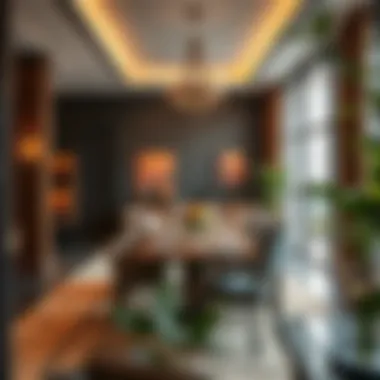

Timelines can often feel like a ticking clock for both clients and designers. Setting clear milestones from the onset ensures that everyone remains on the same wavelength throughout the project.
In the fast-paced environment of Dubai, adhering to timelines is crucial. Designers must evaluate potential delays and communicate these to clients proactively. Here’s how effective timelines can be crafted:
- Set Realistic Deadlines: Understanding the scope of work is essential here. Not everything can be executed in a blink.
- Regular Check-ins: Frequent updates can help manage expectations and alleviate client anxiety.
- Assessing Resources: Ensure that all necessary materials and labor are secured well ahead of time to avoid bottlenecks.
In short, clear communication regarding timelines bolsters trust and satisfaction, leading to a more harmonious design experience.
"The best projects are those where the client's vision and the designer's expertise weave together seamlessly, creating spaces that are not just lived in, but truly cherished."
Understanding client expectations through detailed design briefs lays the groundwork for a successful partnership. By implementing these crucial elements, interior designers in Dubai can navigate the complexities of individual requirements while fostering meaningful client relationships.
The Integration of Technology in Design
In an era where innovation seems to be the name of the game, the integration of technology in interior design is proving to be revolutionary. Particularly in a city like Dubai, where the expectations of aesthetics and functionality rise to dizzying heights every day, adopting the latest technological advancements isn't just a bonus—it's essential. Interior designers here are not only using technology to create stunning environments but also to improve client interactions and project efficiencies. This merging of digital tools with design processes enables designers to push the boundaries of creativity and efficiency.
Virtual Reality in Design Presentation
Virtual reality (VR) has emerged as a powerful tool in the repertoire of interior designers. It allows clients to step into a project before any physical work commences. Imagine waiting for a stunning villa to be built, but instead you slip on VR goggles and walk through a virtual version of your future home. This capability offers a near-tangible experience of space and layout, which helps clients visualize the final product in the most realistic way possible.
Here are some of the key benefits of using VR in design:
- Enhanced Visualization: Clients can see the proposed layouts and make decisions on design elements like colors and furniture placements long before construction begins.
- Immediate Feedback: Real-time adjustments can be made, allowing instant feedback from clients, which ultimately saves time and avoids costly mistakes.
- Competitive Advantage: Designers utilizing VR technology position themselves as forward-thinking professionals catering to today’s tech-savvy clientele.
Smart Home Technologies
As the demand for smart homes rises, designers in Dubai are adapting their projects to incorporate technology that enhances convenience, security, and energy efficiency. Smart home technologies offer solutions that allow homeowners to control various aspects of their living spaces through their smartphones or other devices.
Consider the following aspects of smart home integration:
- Automation: Lights, temperature, and even curtains can be controlled remotely, making for not just a stylish but a highly functional living environment.
- Security: Integrating smart security systems ensures that homeowners have peace of mind, being able to monitor their properties from anywhere.
- Energy Efficiency: Smart systems can significantly cut energy costs, allowing for real-time monitoring and efficient energy usage.
Project Management Software
The complexity of interior design projects, especially in a bustling market like Dubai's, necessitates effective project management. Here, specialized software plays a crucial role. It enables designers to keep all elements of a project organized, from concept to completion.
Key benefits include:
- Task Tracking: Designers can assign tasks, set deadlines, and monitor progress all in one place, ensuring that the project stays on schedule.
- Collaboration: Cloud-based project management tools allow for seamless collaboration between team members, clients, and subcontractors, which is invaluable in a competitive market.
- Resource Management: Software tools provide insights into budgets, materials needed, and timelines, improving efficiency and reducing waste.
"Integrating technology into interior design is not just about tools, it’s about revolutionizing how spaces are conceived and realized."
In summary, technology is no longer an optional add-on for interior designers in Dubai; it's a fundamental aspect that enhances both the design process and client experience. As these innovations continue to shape the landscape of interior design, they will undoubtedly redefine expectations and create new opportunities for designers and clients alike.
The Role of Interior Design in Real Estate Value
Interior design is not merely about aesthetics; it plays a pivotal role in determining the value of real estate, particularly in a market as vibrant and competitive as Dubai. As investors and homeowners dive into property acquisition, understanding how interior design impacts pricing and marketability is essential. This section will explore several key facets of this relationship, illustrating why thoughtful design decisions can substantially elevate property worth.
Design as a Value Multiplier
When executed with precision, interior design can function as a powerful multiplier of real estate value. A well-designed space captures attention, instilling an emotional connection that potential buyers or renters crave. By integrating modern design principles, sustainable materials, and local cultural influences, designers can create atmospheres that resonate deeply with the market.
For instance, a beautifully renovated villa at Emirates Hills won’t just look pleasing; it can command a price premium. Features like open floor plans, optimized lighting, and luxurious finishes draw in buyers, making them willing to pay more. According to industry reports, properties with professional design elements can see an increase of up to 20% in sales value compared to similar, less-stylishly appointed homes.
Marketability of Well-Designed Spaces
The marketability of any property is significantly influenced by its interior design. Prospective buyers are often swayed by how a space feels when they walk through the door. Intuitive layouts, appealing color schemes, and functionality create compelling narratives that draw interest.
Conversely, spaces that lack cohesion or appear cluttered may lead to prolonged market listings or lower offers.
- A key takeaway: Well-designed interiors not only enhance visual allure but also contribute to a seamless flow within the space. This practicality can factor into buyer interest, ultimately affecting speed of sale and listing price.
Furthermore, staging a property can transform it from a simple apartment in Downtown Dubai into a luxurious oasis that tells a story. It can be a make-or-break moment for many potential buyers, positioning the property favorably in an ever-challenging market.
Long-Term Investment Considerations
Investing in interior design is not limited to immediate returns; it offers long-term benefits as well. Well-considered design choices can lead to energy savings, increased durability of materials, and create functional spaces that adapt over time. Buyers are becoming more conscious of the sustainability aspect, and properties that showcase eco-friendly elements are progressively more attractive.
For investors, retaining quality interior design means fewer regrets later on.
- Consider these aspects:
- Resale Value: Properties with high-quality finishes and timeless styles tend to retain value longer.
- Maintenance Costs: Thoughtfully designed spaces may require less upkeep and feature durable materials, mitigating ongoing expenses.
- Emotional Appeal: Spaces that are both functional and beautiful create memories, contributing to higher nostalgic value for future resale.
As the real estate market in Dubai continues to evolve, it becomes increasingly evident that interior design is a crucial ingredient in securing maximum value. Not only does it enhance physical spaces, but it also imbues them with story and significance, which ultimately drives their worth in a fast-paced market.
"Design influences perception; in Dubai's real estate, it's the fine line between success and stagnation."
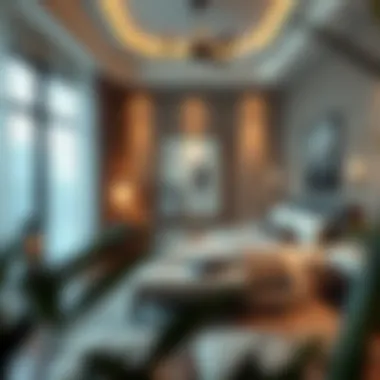
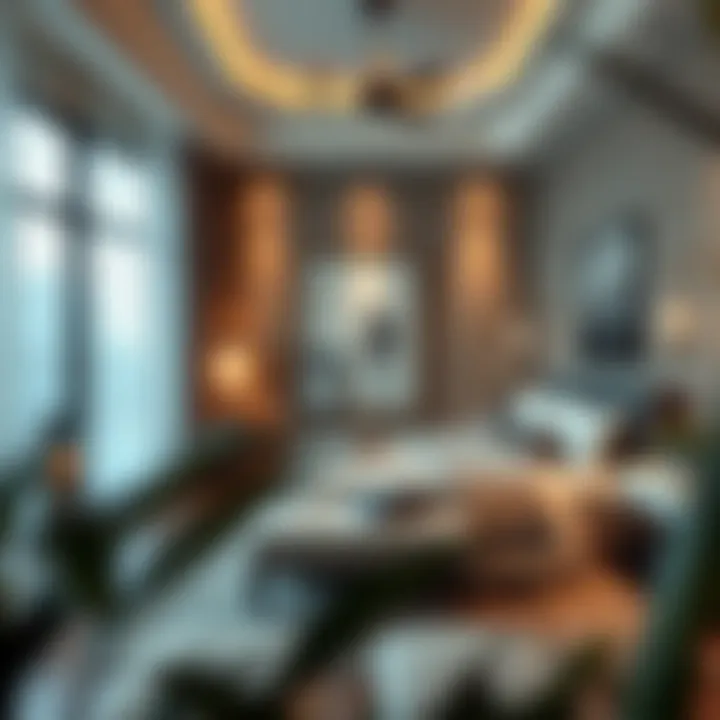
Being mindful of the relationship between interior design and real estate value is imperative for anyone operating in the market. Awareness can lead to smarter investments, textured living experiences, and a sustained appreciation over time.
For more comprehensive insights into property trends and market analysis, visit WAM - Emirates News Agency and REIDIN.
Challenges Faced by Interior Designers in Dubai
Interior designers in Dubai operate in a dynamic and intricate landscape. Yet, this vibrant environment comes with its own set of challenges. Understanding these obstacles is crucial not only for designers themselves but also for clients and industry stakeholders. Being aware of these issues can help foster smoother collaborations and more successful project outcomes.
Navigating Regulatory Frameworks
Dubai is known for its rapid growth and development, making it a hotspot for cutting-edge architecture and innovative interior design. However, along with this fast-paced environment comes a complex set of regulations and codes that designers must navigate. The municipality enforces strict guidelines when it comes to building and design. This includes zoning laws, construction permits, accessibility mandates, and safety regulations.
For example, designers must comply with the standards set by the Dubai Development Authority, which can involve layers of documentation and various approvals. Furthermore, sustainability regulations have also become more prominent, as Dubai aims to position itself as a green city. The need to meet these increasingly stringent guidelines can sometimes slow down the design process or limit creativity. As a result, designers often find themselves in a tug-of-war between compliance and innovative expression.
Competition from Global Players
Dubai has attracted global talent from all corners of the world, resulting in a saturated market. Renowned international interior design firms set up shop alongside a growing number of local players. While this diverse competition can elevate design standards in the region, it also makes it challenging for smaller, emerging designers to carve out their niche.
Many clients lean toward established firms with extensive portfolios and international recognition. This can make it difficult for less-known designers to compete on a level playing field. Emerging talents often have to innovate uniquely or offer customized solutions to stand out against the heavyweights in the industry. It’s a hustle that demands creativity and grit to navigate the competitive waters.
Client Communication Barriers
In a city as diverse as Dubai, the clientele is often made up of individuals from various cultural backgrounds. This rich tapestry offers unique opportunities for design but may also present communication hurdles. Misunderstandings can arise when clients have different expectations or design preferences influenced by their cultural contexts. Additionally, language barriers may complicate communications, leading to vague briefs and potential misalignments in vision.
To overcome these challenges, designers should prioritize clear and consistent communication. Strategies such as visual aids, sketches, and sample materials can help bridge these gaps. Establishing trust and rapport with clients is also critical. Taking time to understand not just the aesthetic preferences but also the lifestyle needs and emotional connections clients have with their spaces can lead to more successful projects.
"Understanding challenges is the first step in overcoming them—especially in a diverse and complex marketplace like Dubai."
In summary, while challenges abound for interior designers in Dubai, being aware of regulations, competition, and client dynamics can pave the way for better strategies. Addressing these obstacles can yield fruitful collaborations, innovative designs, and successful outcomes for both designers and clients.
Future Directions for Interior Design in Dubai
The landscape of interior design in Dubai continues to evolve, reflecting not only the city's rapid development but also the complexities of its multicultural society. Understanding the future directions for interior design in the region is crucial for stakeholders aiming to maintain their edge in a competitive market. Specifically, this discussion will highlight emerging styles, the repercussions of global events, and the changing face of client demographics—all of which play pivotal roles in shaping the way interiors are conceived and executed in this vibrant metropolis.
Emerging Styles and Trends
As urban dynamics shift, so do the aesthetics of interior design in Dubai. One emerging style gaining traction is biophilic design, which seamlessly integrates nature into indoor environments. Designers are finding smart ways to incorporate natural materials and greenery, enhancing not just aesthetics but also the well-being of occupants. This trend aligns well with sustainability initiatives, resonating with a growing clientele that prioritizes eco-friendliness.
Additionally, minimalism continues to enjoy popularity, yet it has evolved to include a warmth that was sometimes missing in earlier iterations. This new wave often features muted tones paired with soft textures, inviting both comfort and sophistication into spaces—a clear reflection of Dubai’s luxurious lifestyle.
Another notable trend is the revival of traditional arts and crafts, often dubbed as heritage chic. Designers bring local customs into play, creating spaces that tell a story while respecting the existing framework of Emirati culture.
- Biophilic Design: Incorporating elements of nature.
- Warm Minimalism: A balance of simplicity and warmth.
- Heritage Chic: Celebrating local culture through the design.
Impact of Global Events
Global events have a cascading effect on interior design trends in Dubai, impacting everything from consumer behavior to material availability. For instance, the increasing emphasis on health and safety due to the recent pandemic has transformed the design approach. Space planning now prioritizes open layouts and multifunctional furniture that adapts to changing needs.
Moreover, international expos and trade fairs have cemented Dubai’s role as a global design hub, attracting talents from all over the world. The seeds of innovation planted during these events foster a culturally rich environment where designers exchange ideas and foray into new styles and techniques.
"The convergence of global trends and local practices creates a melting pot of ideas, shaping the future of interior design in Dubai."
Evolving Client Demographics
As the real estate landscape shifts, so too do the demographics of clients engaging in interior design projects. With an increasing number of expatriates residing in the city, their varied cultural backgrounds influence design preferences and project briefs. This diversity prompts designers to think outside the box, tailoring their approaches to meet the unique needs of clients from different cultural contexts.
Furthermore, millennials and Gen Z are asserting themselves as significant players in the homeowner market. This demographic tends to favor experiential over material possessions, often seeking homes that reflect their values and lifestyle. As a result, the focus on personalized spaces and dynamic interiors is set to intensify, pushing designers to adopt a more client-centric approach.
- Expat Influence: More diverse cultural backgrounds shaping design.
- Millennial Preferences: A shift towards personal and meaningful spaces.
By recognizing and adapting to these future directions, interior designers in Dubai can not only remain relevant but also thrive in an ever-changing environment.
Culmination: The Significance of Interior Design in Shaping Dubai's Identity
Interior design in Dubai speaks volumes about the cultural and economic fabric of the city. It is not merely about aesthetics; it encapsulates a narrative of progress, fusion, and identity. As we close this exploration, it is paramount to appreciate the multifaceted role that interior design plays in the ever-evolving landscape of this dynamic metropolis.
Reflecting Cultural Values
Dubai's interior design resonates with a blend of its rich history and the vibrant cultures that coexist within its borders. From the intricate patterns of traditional Islamic art to the sleek lines of modern design, there is a conscious effort to weave local heritage into the fabric of contemporary spaces.
- Traditional Influences: Designers often draw from motifs that echo the past, be it through color schemes inspired by the desert, or using materials like marble, glass, and wood that are timeless.
- Cultural Narratives: This aspect becomes particularly important for homeowners and businesses seeking to signal their identity in a globalized world. Spaces that reflect local influences foster a sense of belonging and pride.
- Diversity and Fusion: Given Dubai's status as a melting pot, designers frequently integrate elements from various cultures, creating unique spaces that appeal to a broad audience.
"In Dubai, interior design is not just about style; it is a language that communicates cultural identity, progress, and aspirations."
Contributing to Urban Aesthetics
The visual landscape of Dubai is punctuated by architectural marvels and immersive interiors that collectively enhance its urban aesthetics. Interior design contributes to this by ensuring that both public and private spaces are functional yet visually appealing.
- Public Spaces: Malls, hotels, and offices prioritize design that enhances functionality while providing memorable experiences. A visit to a mall, for instance, is transformed into a mini-exploration, with art installations and interactive displays.
- Sustainable Practices: With an increasing emphasis on green architecture, interior designers are also pivoting towards sustainable materials and designs that minimize environmental impact, thereby enhancing the beauty without compromising future generations.
- Connectivity with Nature: Integrating natural elements, such as indoor gardens or water features, into design can create a tranquil environment, which is vital in a bustling city like Dubai.
Positioning Dubai as a Global Design Hub
As the world places increasing value on unique experiences, Dubai is carving out its niche as a leading player in the global design arena. Interior design serves as a crucial component in solidifying this reputation, contributing not only to its economy but also to its cultural diplomacy.
- Hosting International Events: Major events such as the Expo highlight Dubai's commitment to innovation in design, attracting global audiences and designers alike, creating a vibrant exchange of ideas.
- Career Opportunities: The growing demand for innovative design solutions opens various avenues for local talent, thereby nurturing a robust community of creative professionals.
- Cross-Pollination of Ideas: Establishing Dubai as a hub fosters collaboration between local and international designers, leading to groundbreaking concepts that push the boundaries of traditional design.





